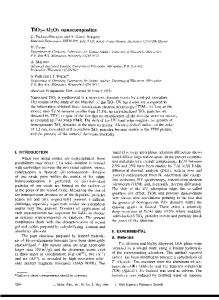Investigation of microstructure and selected properties of Al 2 O 3 -Cu and Al 2 O 3 -Cu-Mo composites
- PDF / 2,986,471 Bytes
- 11 Pages / 595.276 x 790.866 pts Page_size
- 104 Downloads / 357 Views
ORIGINAL RESEARCH
Investigation of microstructure and selected properties of Al2O3-Cu and Al2O3-Cu-Mo composites Justyna Zygmuntowicz 1
&
Joanna Łoś 2 & Bernard Kurowski 2 & Paulina Piotrkiewicz 1 & Waldemar Kaszuwara 1
Received: 22 June 2020 / Revised: 13 October 2020 / Accepted: 10 November 2020 # The Author(s) 2020
Abstract The scope of work included the fabrication of ceramic-metal composites from the Al2O3-Cu and Al2O3-Cu-Mo and examining their microstructure and selected properties. The composites were fabricated by the slip casting method. The rheological behavior, microstructures, X-ray analysis, and mechanical properties were investigated. The rheological study demonstrated that all of the obtained slurries were non-Newtonian shear diluted fluids and stability on time. In both slurries, the flow limit is close to 0 Pa, which is very beneficial when casting the suspensions into molds. The X-ray analysis reveals Al2O3, Cu, and Mo phases in all specimens. No new phases were found in both types of composites after the sintering process. The results provided that the hardness for Al2O3-Cu-Mo composites was equal to 10.06 ± 0.49 GPa, while for Al2O3-Cu, it was equal to 6.81 ± 2.08 GPa. The K1C values measured, with the use of Niihara equation, for composites with and without the addition of Mo were equal to 6.13 ± 0.62 MPa m0.5 and 6.04 ± 0.55 MPa m0.5, respectively. It has been established that the mean specific wear rates of Al2O3-Cu and Al2O3-Cu-Mo samples were 0.35 × 10–5 ± 0.02 mm3 N−1 m−1 and 0.22 × 10–5 ± 0.04 mm3 N−1 m−1, respectively. It was found that molybdenum addition improved wear resistance properties of the composites. Keywords Composites . Slip casting . Mechanical properties . Scanning electron microscopy
1 Introduction One of the most challenging objectives in modern engineering is the continuous design and development of advanced materials for high-performance applications. Advanced ceramics due to the wide range of current and future applications can be considered one of the main directions in the advancement of this challenge. Despite remarkable mechanical properties, such as high hardness and wear resistance, high Young’s modulus, chemical stability, and thermal shock resistance of the advanced ceramic materials, their use in engineering is limited. Low toughness and plasticity, in comparison to the metals, in combination with high sensitivity for the presence of flaws in the structure effectively exclude ceramics from high-performance applications. Considering the above, the * Justyna Zygmuntowicz [email protected] 1
Faculty of Materials Science and Engineering, Warsaw University of Technology, 141 Woloska Str., 02-507 Warsaw, Poland
2
Institute of High Pressure Physics of the Polish Academy of Sciences, 29/37 Sokolowska Str., 01-142 Warsaw, Poland
necessity for new ceramic-based materials with enhanced properties has been clearly demonstrated [1–3]. Composites and especially ceramic-metal composites may be considered a possible solution. In the last decade, a lot o
Data Loading...











